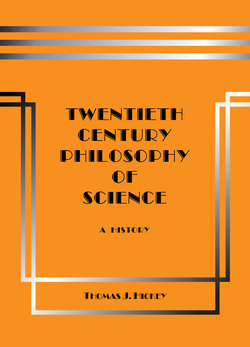Читать книгу Twentieth-Century Philosophy of Science: A History (Third Edition) - Thomas J. Hickey - Страница 61
На сайте Литреса книга снята с продажи.
3.30 Semantical State Descriptions
ОглавлениеA semantical state description for a scientific profession is a synchronic display of the semantical composition of the various meanings of the partially equivocal descriptive terms in the alternative theories functioning as semantical rules and addressing a single problem defined by a common test design.
The above discussions in philosophy of language have focused on descriptive terms such as words and mathematical variables, and then on statements and equations that are constructed with the terms. For computational philosophy of science there is an even larger unit of language, which is the semantical state description.
In his Meaning and Necessity Carnap had introduced a concept of linguistic state description in his philosophy of semantical systems. Similarly in computational philosophy of science a state description is a semantical description but with different content and functions than Carnap’s. The statements and/or equations supplying a discovery system’s input state description and those constituting the output state description are semantical rules. Each alternative theory or law has its distinctive semantics for its constituent descriptive terms. A term shared by several alternative theories or laws is thus partly equivocal. But the term is also partly univocal due to the common test-design statements that are also semantical rules.
In computational philosophy of science the state description is a synchronic and thus a static semantical display. The state description contains language actually used in a science both in an initial state description containing object-language input to a discovery system, and in a terminal state description containing object-language output generated by a computerized discovery-system’s execution. The initial state description represents the frontier of research for the specific problem. Both input and output state descriptions for a discovery-system run address only one problem identified by the test design, and thus for computational philosophers of science they represent only one scientific “profession”.
A discovery-system is a mechanized finite-state generative grammar that produces sentences or equations from descriptive terms or variables. As a grammar it is creative in Noam Chomsky’s sense, because when encoded in a computer language and executed, the system produces new statements, i.e., theories that have never previously been stated in the particular scientific profession. A discovery system is Feyerabend’s principle of theory proliferation applied with mindless vengeance. To control the size and quality of the output, the system tests the empirical adequacy of those novel theories and likely rejects most of them. Associating measurement data with the inputted variables enables empirical testing, so that the system designs are typically one or another type of applied numerical methods.
For semantical analysis the state description consists of universally quantified statements and/or equations. The statements and/or equations from which the terms and/or variables were extracted including theories and test design are part of the state description although not for discovery system input, because they would prejudice the output. Statements and/or equations function as semantical rules in the generated output only. Thus for discovery-system input, the input state description is a listing of descriptive terms and/or variables extracted from the statements and/or equations of the several currently untested theories addressing the same unsolved problem as defined by a test design at a given point in time.
Descriptive terms and/or variables extracted from the statements and/or equations of falsified theories can also be included to produce a cumulative state description for input, because the terms and/or variables from previously falsified theories represent available information at the historical or current point in time. Descriptive terms and/or variables salvaged from falsified theories have scrap value, because they may be recycled through the theory-developmental process. Furthermore terms and variables from tested and nonfalsified theories could also conceivably be included, just to see what new comes out. Empirical underdetermination permits scientific pluralism, and the world is full of surprises.
